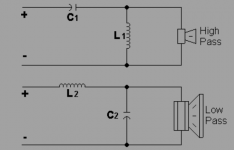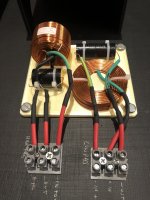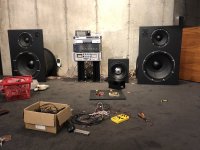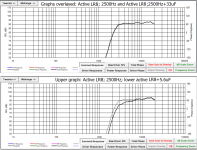Friends,
Summary: Highpass filter impacting signal above filtered range ... why?
I'm running a tri-amped + sub system, with electronic crossover. I still had the passive crossover lying about that I used in a previous iteration.
The problem is that when I'm mucking around with the electronic crossover (symetrix Jupiter 8) it's happened on more than one occaision that I flatten the curfve for the tweeters, sending full range signal down the line... oops. So far no blowups (tough little Vifa D19TD!), but I wanted to put the high-pass from the crossover back in the line to have some protection.
Only when I do so, the treble on low volume really suffers - that's 3 meters listening volume, and it's unbearable on quieter passages. The highpass I also notice really attenuates the soft background hiss that comes out of the headphones jack of my raspberry pi (waiting for the balanced audio HAT).
The electornic crossover cuts in at 2500Hz with steep 48dB LR filter.
The passive components are per graphic C1 5.6uF L1 1.4mH. Only hooked up the high-pass.
I would have expected that the filter attenuates the signal, but it comes across really grainy, almost staticky, on low volumes. High volumes seem OK.
I've bypassed the coil and just hooked the cap in series, to same effect.
When I pull the cap out of the line, the signal comes through as it should, regardless of volume. I can dial it down until the treble gently fades behind the background hiss with my ear hard up against the 8 Ohm Vifa D19TD tweeter. With the cap in between, the background hiss is nearly gone, and the treble just stutters away.
From my calculation the filter should only take effect around 1800Hz and leave the signal above alone. What am I doing wrong?
I really want some protection (from myself doing stupid things) but I don't want to compromise the sound even at minimal hearing volumes (night time listening).
Summary: Highpass filter impacting signal above filtered range ... why?
I'm running a tri-amped + sub system, with electronic crossover. I still had the passive crossover lying about that I used in a previous iteration.
The problem is that when I'm mucking around with the electronic crossover (symetrix Jupiter 8) it's happened on more than one occaision that I flatten the curfve for the tweeters, sending full range signal down the line... oops. So far no blowups (tough little Vifa D19TD!), but I wanted to put the high-pass from the crossover back in the line to have some protection.
Only when I do so, the treble on low volume really suffers - that's 3 meters listening volume, and it's unbearable on quieter passages. The highpass I also notice really attenuates the soft background hiss that comes out of the headphones jack of my raspberry pi (waiting for the balanced audio HAT).
The electornic crossover cuts in at 2500Hz with steep 48dB LR filter.
The passive components are per graphic C1 5.6uF L1 1.4mH. Only hooked up the high-pass.
I would have expected that the filter attenuates the signal, but it comes across really grainy, almost staticky, on low volumes. High volumes seem OK.
I've bypassed the coil and just hooked the cap in series, to same effect.
When I pull the cap out of the line, the signal comes through as it should, regardless of volume. I can dial it down until the treble gently fades behind the background hiss with my ear hard up against the 8 Ohm Vifa D19TD tweeter. With the cap in between, the background hiss is nearly gone, and the treble just stutters away.
From my calculation the filter should only take effect around 1800Hz and leave the signal above alone. What am I doing wrong?
I really want some protection (from myself doing stupid things) but I don't want to compromise the sound even at minimal hearing volumes (night time listening).
Attachments
5.6uF as a simple HP to a nominally 8 ohm tweeter (assuming 8 ohm flat as a resistor) yields
7dB of attenuiation at 1.8kHz, 4dB at 3 kHz etc. Use a larger cap value (33uF) if you desire to not alter the tweeter spl, yet have a protection against dc voltage.
7dB of attenuiation at 1.8kHz, 4dB at 3 kHz etc. Use a larger cap value (33uF) if you desire to not alter the tweeter spl, yet have a protection against dc voltage.
Oh... thanks!
For some reason I was of the belief that the cap was big enough. I'll root around the toolbox see if I can find some bigger values, play with them.
I guess DC protection is a drastic way of putting it. I thought even signal as high as 200Hz could damage a tweeter.
I also assume that the cap has to be bipolar, so the bogstandard electrolyte will not be passable, right?
Attached image: "the night is young"...
For some reason I was of the belief that the cap was big enough. I'll root around the toolbox see if I can find some bigger values, play with them.
I guess DC protection is a drastic way of putting it. I thought even signal as high as 200Hz could damage a tweeter.
I also assume that the cap has to be bipolar, so the bogstandard electrolyte will not be passable, right?
Attached image: "the night is young"...
Attachments
No standard electrolytics.
The crossover you are using would be OK if you are prepared to work with what it is doing to get a total response that you can use. This is easier with some tools than others.
The crossover you are using would be OK if you are prepared to work with what it is doing to get a total response that you can use. This is easier with some tools than others.
Unfortunately philschl has an issue, as some of us have probably known when adjusting filters and they drop out leaving a full range signal.
No standard electrolytics.
The crossover you are using would be OK if you are prepared to work with what it is doing to get a total response that you can use. This is easier with some tools than others.
The passive crossover worked well enough in the previous version of the speakers but now I’ve redesigned and stared playing with the active options I can’t go back. Maybe I’ll try putting the caps in parallel with those from the low pass filter, should give a combined 13uF. Until then I’ll just have to be more careful...
The protection against any AC voltage comes from a HP filter as long as it's working. This is a simulation of a real dome tweeter where one can exactly observe how combining active and passive filter affects frequency response.
The theory would suggest that the cap/filter attenuates the sound. What I wasn’t prepared for was that the sound at low volume was distorting.
- Home
- Loudspeakers
- Multi-Way
- High-Pass filter messing up the treble



